“Pho Types,” a beloved Vietnamese delicacy, is not just a meal; it’s a cultural emblem. Cherished by locals and tourists alike, it’s a fragrant journey through Vietnam’s diverse culinary landscape. Join us in unraveling the essence of Vietnam’s culinary heritage through the rich tapestry of Pho.
See more: Exploring the Flavors of Authentic Vietnamese Cuisine
Contents
Exploring the Diversity of Pho Types in Vietnam
Vietnamese cuisine is celebrated worldwide, and at its heart lies the iconic dish, Pho. This savory noodle soup has many regional variations, each offering a unique culinary experience. Let’s delve into the diverse world of Pho types found in Vietnam.
Pho Ga (Chicken Pho):
- Broth: Pho Ga is known for its clear, delicate chicken broth. It’s prepared by simmering chicken pieces, typically bone-in, and fragrant spices like ginger, star anise, and cloves. This creates a subtly sweet and aromatic base.
- Protein: The dish features tender chicken slices, often boneless, which are poached and served atop the pho noodles.
- Garnishes: Fresh herbs like cilantro and Thai basil, bean sprouts, lime wedges, and sometimes sliced chili peppers are common garnishes. Hoisin and Sriracha sauce can be added for extra flavor.
- Variations: Some variations might include chicken organs like liver or gizzards for added texture and flavor.
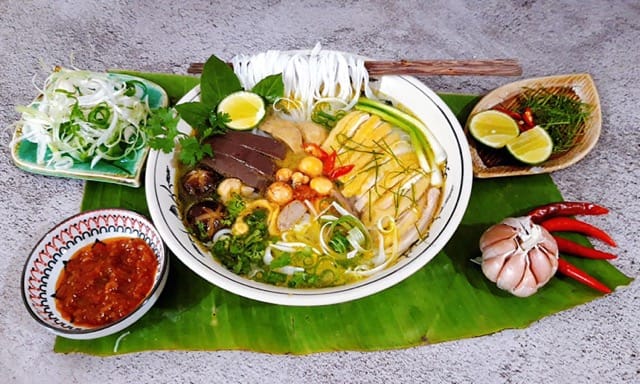
Phở Gà (Chicken Pho) – Source: Internet
Pho Bo (Beef Pho):
- Broth: Pho Bo is famous for its rich and flavorful beef broth. The broth is achieved by simmering beef bones, charred onions, and a medley of spices such as cinnamon, star anise, and cardamom.
- Protein: Thinly sliced beef, typically raw or slightly cooked by the hot broth when served, is a hallmark of Pho Bo. Different cuts of beef are used, offering varied textures and flavors.
- Garnishes: Garnishes include fresh herbs, bean sprouts, lime wedges, basil leaves, and sliced chili peppers. Hoisin and Sriracha sauce are often provided as condiments.
- Variations: Regional differences in beef cuts, spicing, and presentation can be found. In some variations, the beef slices are quickly seared before being added to the broth, enhancing the beefy flavor.
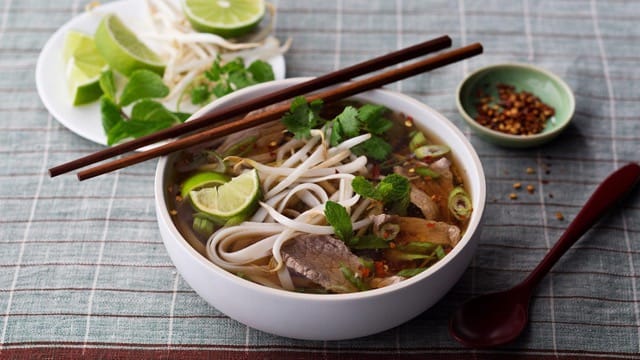
Pho Heo (Pork Pho):
- Broth: Pork Pho features a heartier, pork-based broth made by simmering pork bones, pork belly, and sometimes other cuts like ribs. It has a robust, meaty flavor.
- Protein: The dish is adorned with various cuts of pork, such as tender belly slices and pork ribs. The meat is typically slow-cooked until tender.
- Garnishes: Similar to other Pho types, it’s garnished with fresh herbs, bean sprouts, lime wedges, basil leaves, and sliced chili peppers. Sauces like Hoisin and Sriracha are often offered.
- Variations: Regional variations might introduce unique cuts or preparation methods, making each bowl of Pho Heo a distinctive culinary experience.
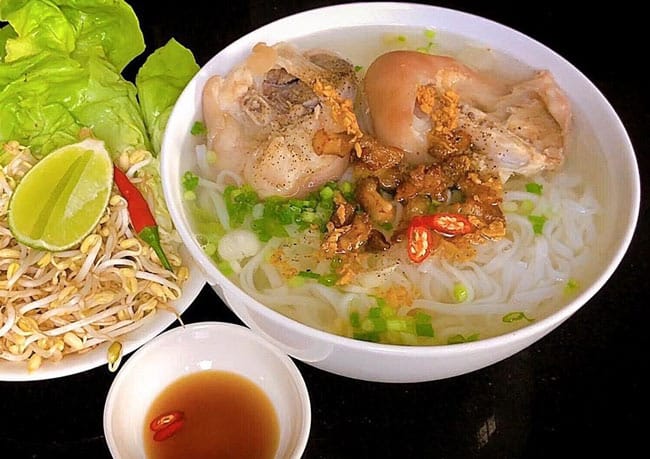
Phở Heo (Pork Pho) with Pork’s Leg – Source: Internet
Pho Chay (Vegan Pho):
- Broth: Pho Chay caters to vegetarians and vegans with a flavorful vegetable-based broth. The broth is crafted using ingredients like mushrooms, vegetable stock, and a blend of herbs and spices for depth of flavor.
- Protein: Instead of meat, Pho Chay uses plant-based proteins like tofu or seitan. These protein sources are infused with the flavors of the broth and provide a satisfying, meat-free alternative.
- Garnishes: Garnishes remain the same, including fresh herbs, bean sprouts, lime wedges, basil leaves, and chili peppers. Hoisin and Sriracha sauces are available for added taste.
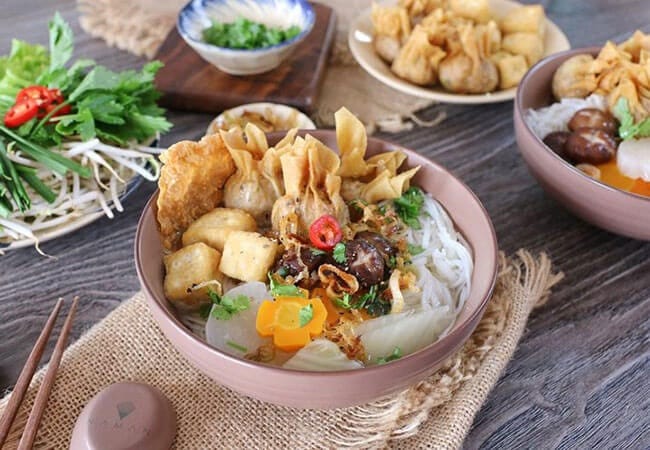
Gluten, Tofu, Mushroom Are Toppings In Pho Chay (Vegan Pho) – Source: Internet
Dry Pho Varieties:
- Phở Khô (Mixed Pho): Pho Kho is a unique variation where the noodles are cooked separately and served dry, along with a bowl of hot, flavorful broth. Diners can control the noodle-to-broth ratio, making it a customizable and interactive dining experience.
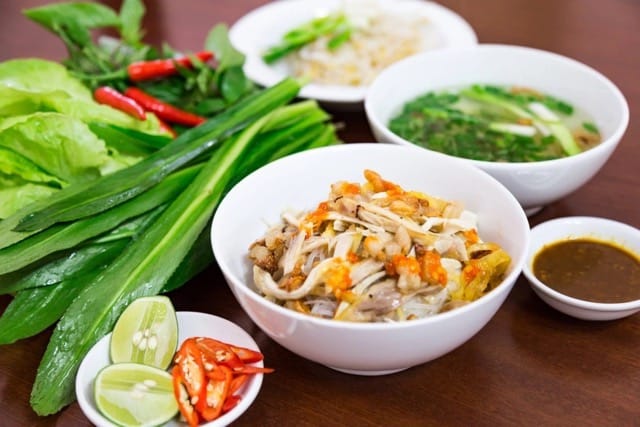
Pho Kho (Dry Pho or Pho 2 Bowls) – Source: Internet - Phở Cuốn (Pho Rolls): Pho Cuon offers a twist on the traditional soup. Pho noodles are rolled up with a combination of ingredients like beef, herbs, and vegetables, creating a delightful fusion of flavors and textures. It’s often served with a dipping sauce.
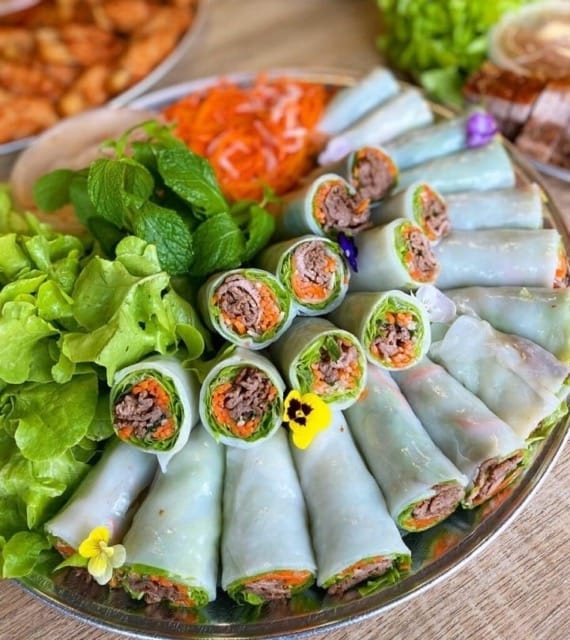
Pho Cuon (Pho Rolls) Is A Must-Try Dish – Source: Internet - Phở Chua (Sour Pho): Pho Chua introduces a tangy element to the dish by incorporating lime or vinegar into the broth. This imparts a unique sour flavor, adding an intriguing contrast to the traditional savory taste.
Each Pho type’s distinct character arises from its unique ingredients and preparation methods. For Pho Ga, chicken is simmered with aromatic spices like ginger and star anise, while Pho Bo relies on beef bones, charred onions, and a blend of herbs. Pork Pho uses a mix of pork cuts, including ribs and belly, to infuse the broth with a hearty taste. Vegan Pho relies on a vegetable-based broth and a medley of plant-based proteins like tofu or seitan, delivering a wholesome, meat-free option.
In the case of Dry Pho varieties, such as Pho Khô and Pho Cuon, the focus shifts to the presentation. Noodles are cooked to perfection and served separately from the broth. Pho Chua, on the other hand, introduces a tangy element to the broth with the addition of lime or vinegar.
Embark on a culinary adventure with Vietnamese street food.
The Essence of Vietnamese Pho Culture
Beyond its culinary significance, Pho is an integral part of Vietnamese culture, deeply rooted in tradition and heritage.
Cultural Significance
Pho represents more than just a meal in Vietnam; it embodies a rich tapestry of history, customs, and community. The preparation and sharing of Pho hold a special place in Vietnamese family gatherings and celebrations. It’s a dish that brings people together, fostering a sense of togetherness and unity.
Regional Variations
Vietnam’s diverse regions contribute to the wide array of Pho types. The northern city of Hanoi is renowned for its Hanoi-style Pho, characterized by simpler, more traditional flavors. In contrast, the southern city of Saigon (Ho Chi Minh City) is famous for Saigon-style Pho, known for its bold and vibrant taste. Central Vietnam offers unique variations that incorporate regional ingredients and flavors, making each bowl of Pho a reflection of its locale.
The Role of Herbs
A critical aspect of Pho’s cultural significance is the use of fresh herbs and garnishes. Diners customize their bowls with a selection of herbs, including basil, cilantro, and mint. This practice not only enhances the flavor but also showcases the importance of fresh, locally sourced ingredients in Vietnamese cuisine.
Don’t fret about sticking to your diet; Vietnamese cuisine provides healthy food options.
Discovering the Best Pho in Vietnam
Pho, the renowned Vietnamese noodle soup, is a cherished dish embraced by both locals and visitors. When searching for the finest Pho in Vietnam, one’s journey often begins with the unpretentious pho stalls that line the streets.
Pho Stalls: A Taste of Authenticity
Enjoying Pho at a street-side pho stall is a quintessential experience in Vietnam, offering a glimpse into the heart of Vietnamese culinary culture.
1. Local Insight: These pho stalls are widespread across Vietnam, from the bustling streets of Hanoi to the vibrant alleys of Ho Chi Minh City. Locals and hotel receptionists are valuable sources of recommendations when it comes to finding the best Pho. They can direct you to hidden gems that may not be widely known.
2. Authentic Flavors: Street-side pho stalls often offer the most authentic Pho experiences. Here, recipes for the savory broth and secret spice blends may be steeped in tradition and passed down through generations. The ambiance, though simple, immerses you in the true essence of Vietnam. You’ll be surrounded by locals relishing their bowls of Pho, confirming that you’ve found a remarkable spot.
Exploring Restaurants: A Premium Pho Experience
While pho stalls provide authenticity and local charm, Vietnamese restaurants offer a more upscale and diverse experience, presenting Pho on their menus.
1. Culinary Variety: Restaurants typically feature a broader range of Pho options. Whether you seek the classic Pho Bo (beef Pho), the lighter Pho Ga (chicken Pho), or even the vegetarian Pho Chay, restaurants cater to a wide range of tastes. This variety is ideal for those interested in exploring various Pho types in one place.
2. Comfortable Atmosphere: Dining in restaurants generally offers a more comfortable setting with air conditioning and comfortable seating. This is a great choice for those who prefer a leisurely meal or when visiting during the hot summer months.
3. Price Considerations: It’s important to note that the cost of Pho in restaurants may be higher compared to street-side stalls. This price difference accounts for the added comfort, ambiance, and the broader menu selection available at restaurants.
Making Pho at Home: Recipes and Cooking Tips
Pho, the beloved Vietnamese noodle soup, need not be confined to restaurant visits. Crafting this iconic dish in the comfort of your home can be a rewarding culinary adventure. Here, we provide you with essential information and guidance to help you embark on your homemade Pho journey.
Crafting Phở Bò (Beef Pho) at Home
Phở Bò, or Beef Pho, is a beloved Vietnamese dish celebrated for its rich and savory flavors. While it’s often enjoyed at restaurants, you can recreate this iconic dish in the comfort of your home. Here’s how to craft a delicious bowl of Phở Bò
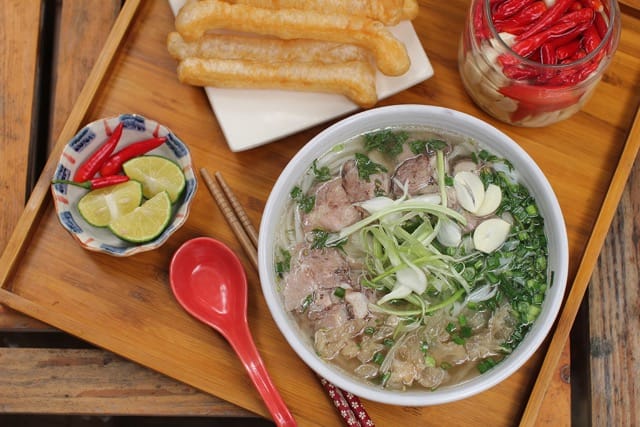
Ingredients
For the Broth:
- 2-3 pounds of beef bones (such as oxtail and marrow bones)
- 1 large onion, unpeeled and halved
- 3-inch piece of ginger, unpeeled and sliced
- 3-4 star anise pods
- 5-6 cloves
- 2-3 cinnamon sticks
- 4-5 cardamom pods
- Salt and sugar to taste
For the Soup Base:
- 1 pound of rice noodles (Pho noodles)
- 1 pound of beef (flank, sirloin, or brisket), thinly sliced
- Optional: Meatballs or tendon for added texture
- Fresh herbs for garnish (cilantro, Thai basil, bean sprouts)
- Lime wedges
- Sliced chili peppers (optional)
- Hoisin sauce and Sriracha for condiments
Instructions
1. Preparing the Broth:
- Roast the onion and ginger in the oven or over an open flame until charred.
- In a large stockpot, add the beef bones and enough water to cover them. Bring to a boil, then simmer for a few minutes. This step helps remove impurities.
- Drain and rinse the bones under running water.
- Return the cleaned bones to the pot, along with the roasted onion and ginger, star anise, cloves, cinnamon, and cardamom.
- Fill the pot with water (about 4-5 quarts) and bring it to a boil.
- Reduce the heat and simmer for at least 4-6 hours. The longer you simmer, the richer the flavor. Skim off any impurities that rise to the surface.
- Season the broth with salt and sugar to taste.
2. Preparing the Noodles:
- If you use fresh pho noodles, just rinse them before pouring in the broth. For dried pho, boil it first and blanch it in cold water to make the noodles more supple.
3. Cooking the Beef:
- Thinly slice the beef into paper-thin pieces. You can briefly blanch the beef in the hot broth or simply add it raw to your bowl.
4. Assembling Your Bowl:
- In each serving bowl, place a portion of cooked noodles.
- Add slices of beef on top of the noodles.
- Ladle the hot broth over the noodles and beef. The heat will cook the beef slices.
- You can also add meatballs or tendon if desired.
5. Garnishing and Flavoring:
- Top your Phở Bò with fresh herbs like cilantro and Thai basil.
- Add bean sprouts for a delightful crunch.
- Serve with lime wedges for a citrusy touch.
- Sliced chili peppers can be added for a spicy kick if you prefer.
- Offer Hoisin sauce and Sriracha on the side for condiments. Diners can customize their Pho to their liking.
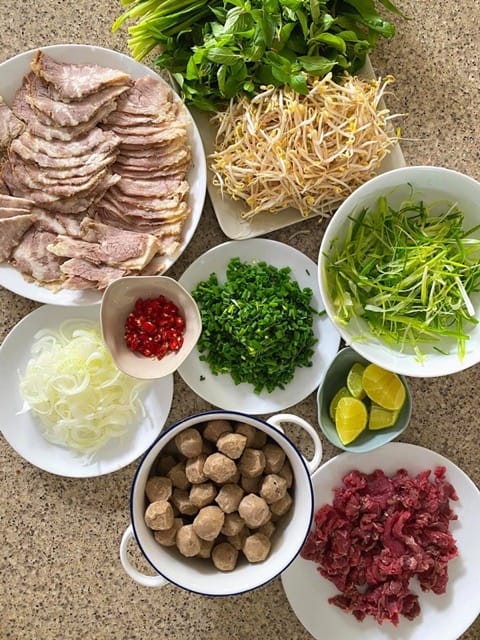
Garnishing Your Pho With These Yummy Toppings – Source: Internet
6. Serve and Enjoy:
- Phở Bò is traditionally served piping hot. Each diner can garnish and flavor their bowl according to their preferences.
You have various options to relish Vietnamese dishes and cuisine; consider taking a leisurely walk through Vietnamese markets for a truly authentic experience.
Conclusion
In closing, Pho, with its myriad of types and cultural significance, epitomizes Vietnamese cuisine. From bustling streets to refined restaurants, its appeal is undeniable. We encourage readers to delve into the world of Pho during their visit to Vietnam, savoring the iconic flavors and exploring a culinary journey infused with tradition and heritage.
Frequently Asked Questions (FAQ)
Q1: What type of noodles are typically used in pho?
A1: Pho is traditionally made with flat, rice noodles. These delicate, thin noodles are the foundation of this iconic Vietnamese dish.
Q2: What type of beef is traditionally used in pho?
A2: In traditional Pho recipes, beef of various cuts is used, including flank steak, brisket, and eye of round. The beef is typically sliced thinly and cooks in the hot broth as it’s served, ensuring a tender and flavorful experience.


Related Posts
Saigon’s “Flower Market Replica”: Where To Find Them
Ho Chi Minh City’s floral charm is not limited to its bustling wholesale markets. Imagine wandering through a place where vibrant petals, fragrant blooms, and the spirit of traditional Vietnamese markets come alive—without the overwhelming crowds. A flower market replica captures that magic, blending the beauty of fresh flowers with the charm of a curated, […]
Is it Safe to Travel to Vietnam Right Now? A Complete 2025 Guide
Vietnam has emerged as one of Southeast Asia’s most captivating destinations, drawing millions of visitors annually with its rich culture, stunning landscapes, and incredible cuisine. However, many travelers still ask: Is it safe to travel to Vietnam right now? This comprehensive guide provides you with everything you need to know about Vietnam travel safety in […]
Ho Chi Minh Cu Chi Tunnels Tour: The Ultimate Guide
The Cu Chi Tunnels stand as one of Vietnam’s most remarkable historical sites, offering visitors a profound glimpse into the ingenuity and resilience displayed during the Vietnam War. For travelers, a Ho Chi Minh Cu Chi tunnels tour represents an essential experience that combines education, adventure, and deep cultural understanding. This comprehensive guide will help […]